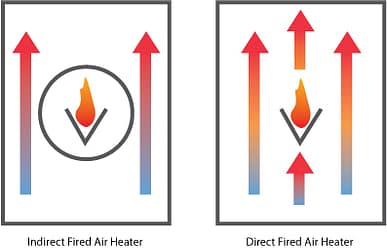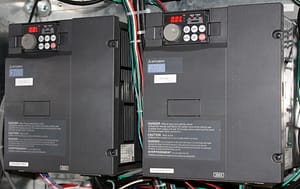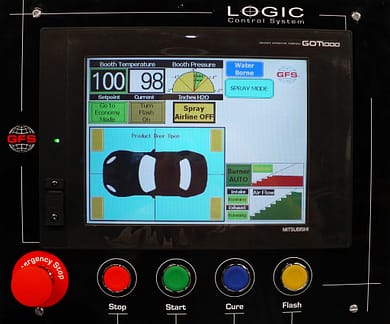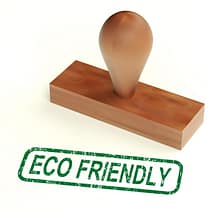Time to once again focus our attention on things we can do, big and small, to help reduce our impact on our environment and develop a plan for sustainable growth in to the future.
We feel it would be very appropriate to talk about some of the aspects of paint booth technology that have changed to reduce energy consumption and be more efficient, while also contributing to a more effective paint environment. Not only do these technologies reduce the impact of operating a paint booth on the environment, but also produce a cleaner, brighter, more productive shop!
You might not think much has changed in terms of paint booth lights, but the reality is that it’s come a long way. As you may know, there are several different types of fluorescent light tubes. Traditional paint booth lights typically use T-12 light tubes, which are similar to the ones found in older office buildings.Recently, the majority of paint booth manufacturers have switched to T-8 light tubes, which are slimmer in profile, and use less energy to produce the same amount of light. Sometimes certain paint booth applications will allow for the use of T-5 light tubes, which are even slimmer, even brighter, and still use less energy.
Take a look at the lights in your paint booth, and if you’re still using the old T-12 tubes, you might consider upgrading those lights to a more energy-efficient light fixture with T-8 or T-5 tubes. While you’re at it, you might as well examine the rest of the lighting in your facility, too. Replacing those energy-guzzling metal halide high-bay lights with new fluorescent high-bay lights can save a ton of energy and do a better job of illuminating your shop!
This is an age-old argument that seems to never go away. When you’re talking about air heaters on paint booths, there are two designs that are common. Direct Fired and Indirect Fired. What’s the difference? Well, here’s an illustration showing how the air actually gets heated inside the unit:

Because it’s a two-step process to get the air heated, indirect fired units are much less fuel efficient, and take much longer to get the air up to the proper temperature. These are two main reasons why direct fired is essentially the ‘industry standard’ when it comes to paint booth air heaters.
If your booth runs with an old style indirect fired air heater, you might want to consider upgrading to a direct fired unit. Retrofits are fairly simple, and you’ll not only notice a big improvement in fuel savings, but also a jump in performance for your booth. Getting up to proper temperature faster will save time and increase production.
*NOTE: There are some applications where usage of indirect fired heaters is mandated by law, so be sure to check with regulatory officials before you buy any new equipment. GFS would be happy to help you determine what the right kind of equipment is that you’ll need for your shop.

VFDs are electronic control devices that act like the gas pedal in your car. They control when electricity is fed to the motor and how much. By adding VFDs to paint booth control systems, many capabilities were added to adjust the airflow in the cabin that used to be done mechanically through dampers.
Now, instead of restricting the airflow mechanically, the VFDs allow the motors to simply slow down to any speed specified by the operator. This enables much more precise control over the airflow inside the cabin and minimizes the energy necessary to maintain it.
In addition, without VFDs paint booth motors would generate a big ‘spike’ in electricity draw the moment they were switched on. This huge spike of energy consumption is completely eliminated with the use of VFDs, as they allow the motor to gradually ‘ramp up’ to speed.
VFDs can be retrofit into existing paint booths to provide energy savings, but be sure to speak with a knowledgeable paint booth tech to ensure you get the proper system that is compatible with your equipment.
An energy saving feature made possible by VFDs, Economy Mode was developed by GFS engineers to reduce energy and fuel consumption automatically during times when the booth is idling.
When the painter is not actually spraying, there is no practical need for the airflow to be at 100% speed if there is no overspray to remove. So, during those idle times the airflow can be reduced to about 50% to maintain a clean environment without shutting the booth off entirely. Then, when the operator is ready to begin painting, an interlock detects when the trigger on the gun is pulled, and the airflow goes back up to 100% automatically.
Because Economy Mode reduces the airspeed during idle times, the necessary number of BTU’s being pumped out by the heater to keep the air temperature at optimum is also reduced. Not only does Economy Mode save you electricity by reducing the speed of the motors, it also reduces fuel consumption as well, all while maintaining a clean, properly heated paint environment.
Every paint has unique properties that determine how it cures. Bases or clears, sovlent-based or waterborne, each one has an ‘optimum’ cure cycle that dictates the best temperature at each stage of the cure process. Control panels that have SmartCure technology built into them automate the process of adjusting the temperature to the correct point in the cure cycle. Once the unique profiles for the coatings you are using are programmed in to the control panel, all the user needs to do is select the right profile, and hit the ‘CURE’ button. The SmartCure control panel does the rest, creating the perfect temperatures for the perfect duration for the coatings you spray. 

One of the best ways to highlight your business is through a story that you can share across your online platforms. It humanizes your business and shows that your business can make a meaningful impact. Your testimonial would be used as a project profile on the GFS Booth Blog and can be shared on your website and/or social media channels.
Complete this form and we’ll be in touch to showcase your company.

Shop a variety of GFS aftermarket products, including booth protection products and mobile accelerated curing units. And enjoy the convenience of fast and free ground shipping throughout the contiguous United States.

Located at GFS’ headquarters in Osseo, Wisconsin, the Center for Excellence is an innovative facility featuring an automotive refinish training center, as well as a separate space dedicated to technical product training.

GFS is continuously searching for talented, ambitious individuals to join our team. We aim to provide our employees with every opportunity to make an impact on the company and find their niche along the way — weather in a production, field services or an office position.